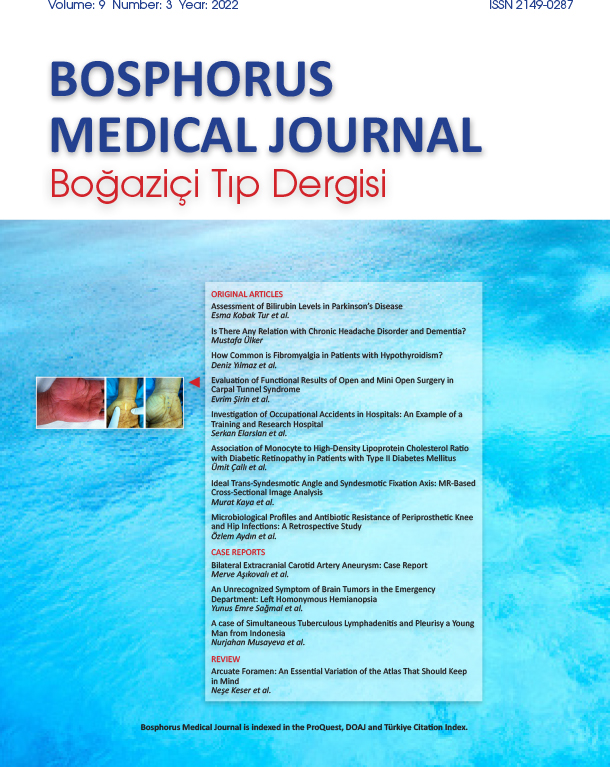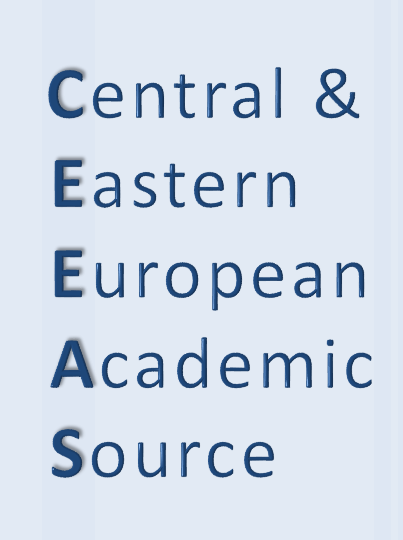Volume: 9 Issue: 2 - 2022
| BRIEF REPORT | |
| 1. | Frontmatters Pages I - IX |
| ORIGINAL RESEARCH | |
| 2. | Comparison of Laparoscopic and Conventional Repair in the Treatment of Peptic Ulcer Perforation Anıl Ergin, Yasin Güneş, İksan Taşdelen, Mehmet Mahir Fersahoğlu, Nuriye Esen Bulut, Ahmet Çakmak, Emre Teke, Erdem Durum, Anıl Bayram, M.timuçin Aydın, Birol Ağca doi: 10.14744/bmj.2021.20981 Pages 73 - 80 INTRODUCTION: Peptic ulcer disease (PUD); it is caused by the disturbance of the balance between gastric acid-pepsin secretion and the mucous barrier. Approximately 4 million people around the world are affected by PUD every year. The incidence of PUD varies between 1.5 and 3% and complications are seen in approximately 1020% of these patients. In this study, the efficiency of laparoscopic repair and conventional repair methods in Peptic ulcer perforation (PUP) treatment was compared. METHODS: A total of 169 patients who were operated for PUP between January 2011 and December 2019 were included in the study. Omental patch application with primary repair or only omental patch application techniques were applied to the perforation area for PUP repair. Patients in the study; age, gender, the American Society of Anesthesiologists (ASA) scores, operation times, peroperative and post-operative complications, hospitalization times, perforation locations, and reasons for readmission were evaluated and the information was retrospectively scanned and recorded in a previously prepared database. RESULTS: Post-operative complications were observed in 19.3% of the patients who underwent conventional repair, in 10.5% of the patients who underwent laparoscopic repair, and in 12.5% of the patients who converted to conventional repair from laparoscopic repair, and there was no statistically significant difference between them (p>0.05). Mortality developed in 11.3% of cases with conventional repair, in 10.8% of cases with laparoscopic repair, and in 12.5% of cases that converted to conventional repair from laparoscopic repair, and there is no statistically significant difference between them (p>0.05). DISCUSSION AND CONCLUSION: In this study, although there was no statistically significant difference in efficacy and safety between laparoscopic repair and conventional repair in PUP, we found that laparoscopic repair was advantageous over conventional repair in many aspects. We think that the surgical method to be chosen should be decided in line with the surgeons experience. |
| 3. | The Effects of Dilation Technique in Percutaneous Nephrolithotomy: One-Shot Versus Sequential Dilation Mehmet Sevim, Okan Alkış, İbrahim Kartal, Fatih Uruç, Bekir Aras doi: 10.14744/bmj.2021.58561 Pages 81 - 86 INTRODUCTION: In this study, the authors aimed to compare the results of one-shot dilation (OD) and sequential dilation (SD) techniques which are used to access in patients who had undergone percutaneous nephrolithotomy (PCNL). METHODS: The authors retrospectively evaluated the data of 159 patients who had undergone PCNL between July 2017 and December 2020 in our clinic. The dilation methods were compared concerning demographic characteristics, operation time, fluoroscopy time, hemoglobin decrease, creatinine increase, complication rate, length of hospital stay, and operation success rate. RESULTS: While OD was applied to 79 patients, SD was applied to 80 patients. The mean length of operation time and fluoroscopy time were shorter in the OD group than SD group (51.14±22.33 vs. 60.19±18.91 min, 119.70±51.03 vs. 136.54±44.24 s, p<0.001 p=0.028, respectively). The mean operation time was found to be statistically significantly lower in the OD group (51.14±22.33 and 60.19±18.91 min, respectively) (p<0.01). Although the duration of fluoroscopy was lower in the OD group than in the SD group, no statistically significant difference was found (119.70±51.03 and 136.54±44.24 s, respectively) (p>0.01). No differences were found between OD and SD groups in terms of success and complication rate (91% vs. 85.0% and 11.3% vs. 15%) p≥0.05 (p>0.01). DISCUSSION AND CONCLUSION: The OD technique is a successful access method that can be utilized safely in patients considered for PCNL operation, contributing directly to the reduction of entry, operation, and fluoroscopy times without increasing complication rates. |
| 4. | Factors Affecting Bone Mineral Density in Inflammatory Bowel Disease Mehmet Köroğlu, Macit Ümran Sandıkçı doi: 10.14744/bmj.2021.09709 Pages 87 - 92 INTRODUCTION: Inflammatory bowel disease (IBD) is a chronic disease, in which autoimmunity has been thought to involve the mucosal barrier, leading to a chronic inflammation and affecting different regions and layers of the gastrointestinal tract. The main types of IBD include ulcerative colitis (UC), Crohns disease (CD), and indeterminate colitis which often cannot be distinguished from the other ones. The prevalence of reduced bone mineral density (BMD) is higher in patients with IBD than healthy individuals. In this study, we aimed to evaluate the BMD in patients with UC, CD, and in healthy individuals. METHODS: A total of 71 IBD patients (21 CD, 50 UC) and 30 age- and sex-matched healthy individuals were included in this prospective study. Dual-energy X-ray absorptiometry was performed to measure BMD of the vertebra and femoral neck. RESULTS: There was no significant difference in the age, sex, and body mass index between the study and control groups (p<0.05). The BMD values were significantly lower in 16 of 21 CD patients (76.2%). A total of 27 patients (54%) with UC had pathological T-scores, indicating borderline significance (p=0.058). The reduction in BMD was not significant between the IBD patients treated with >5 g/day corticosteroids and those treated with ≤5 g/day or treatment-naive patients (p>0.05). DISCUSSION AND CONCLUSION: Our study results suggest that BMD is significantly lower in IBD patients, particularly in CD patients. |
| 5. | Serum Uric Acid Levels in Schizoaffective Disorder Aslı Kazgan Kılıçaslan, Sevler Yıldız, Osman Kurt, Sevda Korkmaz doi: 10.14744/bmj.2021.19981 Pages 93 - 101 INTRODUCTION: The level of uric acid (UA) in the blood can indicate the oxidative stress state of the body in some dis-eases. In this study, it was aimed to investigate serum levels of UA in schizoaffective disorder (SD), which attracts attention with its role in oxidant-antioxidant pathways and to compare it with healthy controls. METHODS: The study included 67 patients with SD in remission and 51 healthy controls. Sociodemographic data form and positive and negative syndrome scale (PANSS), young mania rating scale (YMRS), and beck depression inventory (BDI) scale were administered to all participants. Then, venous blood samples were taken from all the participants to study the serum UA levels as well as the routine blood biochemistry parameters. RESULTS: Serum UA levels, PANSS sub-dimensions and total scores, and YMRS and BDI scores of the patients were significantly higher than the control group. There was a significant positive correlation between serum UA levels and PANSS, YMRS, and BDI. DISCUSSION AND CONCLUSION: Serum UA levels of SB patients were found to be higher than healthy controls. This elevation appears as a finding independent of mood episodes or psychotic episodes. The fact that SB patients have higher serum UA during remission periods than healthy controls makes us think that this situation may be specific to the disease itself. Our results can give us a clue about the pathophysiology of SB. |
| 6. | Comparison of Emergence and Recovery in Different Age Pediatric Patients Undergoing Ambulatory Surgical Procedures Mesure Gül Nihan Özden doi: 10.14744/bmj.2022.03360 Pages 102 - 107 INTRODUCTION: In this study, we aimed to investigate the effects of childrens age on awakening and recovery in ambulatory pediatric surgery cases. METHODS: The data of patients who underwent ambulatory surgical procedures were reviewed retrospectively, and the files of ASA I patients who used sevoflurane as an induction and maintenance agent and were placed in a laryngeal mask for airway maintenance were reviewed. Patients who used neuromuscular blockers during anesthesia were not included in the study. The patients were divided into two groups according to their age, as Group K (age of 36 months and below) (n=34) and Group B (age of over 36 months) (n=28). Hemodynamic data of the patients, laryngeal mask removal times at the end of surgery, and extubation times were evaluated. The Aonos 4-Point Scale, which evaluates the agitation of the patients in the recovery unit, and the Steward Recovery Score, which evaluates the recovery quality, were examined. RESULTS: There was no difference according to age in terms of laryngeal mask removal times and eye opening times. Aonos 4-Point Scale and Steward Recovery Scale were found to be higher in children aged 36 months and below in recovery unit. DISCUSSION AND CONCLUSION: While the laryngeal mask removal times and extubation times were similar in all age groups we examined in our study, recovery was faster in younger patients and emergence agitation was observed more frequently. |
| 7. | Investigation of Neuropathic Pain in Women with Low Vitamin D Levels Derya Çırakoğlu, Ali Aslan doi: 10.14744/bmj.2022.93899 Pages 108 - 112 INTRODUCTION: Besides the known metabolic effects of vitamin D, its role in modulation of pain is controversial. In our study, we aimed to investigate the possible relationship between demographic data and some biochemical values of blood who has in female patients with low vitamin D levels and neuropathic pain. METHODS: The data of the patients who applied to the Physical Medicine and Rehabilitation Polyclinic between January 2017 and January 2018 were evaluated retrospectively. Seventy-nine female patients with low vitamin D levels who met the inclusion criteria were included in the study. The painDETECT pain questionnaire was used to evaluate the presence of neuropathic pain. According to this questionnaire, the patients were divided into three groups as no neuropathic pain, suspicious, and present. RESULTS: Neuropathic pain component was detected by the painDETECT questionnaire in 15 (19%) of the female patients with low vitamin D levels. There was no statistically significant difference between neuropathic pain groups and age, education levels, number of births, body mass index as well as plasma values of vitamin D, alkaline phosphatase, parathyroid hormone, and calcium in female patients with low vitamin D levels. DISCUSSION AND CONCLUSION: In this retrospective study, we observed similar biochemical data in patients with different degrees of neuropathic pain and low vitamin D levels. We think that it can be prospectively investigated whether vitamin D supplementation will make a difference in treatment the patients with low vitamin D levels and neuropathic pain. |
| 8. | Akut Taşlı Kolesistitli Yaşlı ve Komorbid Hastalarda Laparoskopik Kolesistektomiye Tamamlayıcı veya Alternatif Bir Yöntem Olarak Perkütan Kolesistostomi Gülşah Yıldırım, Hakkı Muammer Karakaş, Özge Fındık doi: 10.14744/bmj.2022.31644 Pages 113 - 120 INTRODUCTION: The technical and the clinical efficacy of percutaneous cholecystostomy (PC) in the management of acute calculous cholecystitis, factors affecting postprocedural morbidity and complications, and predictive factors that affect long-term results including recurrence of disease and eventual cholecystectomy were evaluated in a cohort of elderly with comorbid diseases. METHODS: The study group consisted of 80 PC patients, aged 50 or older. They were graded/classified according to Tokyo Guidelines 2018 for Acute Cholecystitis (TG18), Charlson Comorbidity Index (CCI), and the American Society of Anesthesiologists Physical Status Classification System. RESULTS: The technical success rate was 100%. The clinical efficacy was 65%, and the partial clinical efficacy was 93.33%. The 30-day mortality due to comorbid conditions was 11.25% and the mean time to death was 14.78±5.91 days. Patients who died and who survived were significantly different regarding mean ASA scores (p=0.003) and mean TG18 grades (p=0.032). Major complication was seen in only 2.5% and minor complication was seen in 3.75% patients. The median time from PC to discharge was 5 days. During a 12-month course, 18.75% of patients died. Of the remaining patients, 86.15% were able to be managed only with a temporary PC. The 1-year interval cholecystectomy rate was 13.85%. The median time to cholecystectomy was 72.50 days with a range between 7 and 340 days. There was no relationship between TG18/CCI and the subsequent need for cholecystectomy. DISCUSSION AND CONCLUSION: PC provides a significant clinical improvement in the early course and is life-saving in elderly and comorbid patients with acute calculous cholecystitis. |
| 9. | The Relationship of Serum Magnesium Levels with Etiology, Lesion Size, and Localization in Ischemic Stroke Mustafa Ülker, Tuğçe Toptan, Rahşan Karacı, Mehmet Demir, Saime Füsun Domaç doi: 10.14744/bmj.2022.04706 Pages 121 - 126 INTRODUCTION: Magnesium is known to have important effects on vascular system and deficiency of magnesium triggers vasoconstriction and facilitates vascular endothelial damage. There were conflicting results in several studies searched for relationship between magnesium levels, etiologic subtypes, and lesion size in ischemic stroke. We aimed to examine relationship between serum magnesium levels and etiology of stroke as well as lesion size and localization. METHODS: A total of 545 patients over the age of 18 years who presented within the first 24 h of acute ischemic stroke and 189 healthy controls were included in the study. Patients were grouped according to TOAST classification and also as anterior and posterior circulation infarcts. Infarct volume was estimated using MRI scan as large (≥5 cm3) and small (<5 cm3) infarct. The relationship between serum magnesium levels and etiology, lesion size, and localization was examined. RESULTS: Serum magnesium level was 1.90±0.23 mg/dL in the patient group and 1.93±0.18 mg/dL in the control group, and no statistically significant difference was found (p=0.11). The mean magnesium level was 1.90±0.2 mg/dL in the atherothrombotic; 1.87±0.2 mg/dL in the cardioembolic; 1.88±0.18 mg/dL in the lacunar; 1.92±0.2 mg/dL in the undetermined; and 1.91±0.2 mg/dL in the other stroke group. There was no statistically significant difference between the magnesium levels according to etiology (p=0.25) and localization (p=0.109).The mean magnesium level was 1.87±0.24 mg/dL and 1.91±0.2 mg/dL in the large and small infarct groups, respectively. An inverse rela-tionship between mean magnesium levels and the infarct size was found (p=0.044, r=−0.087). DISCUSSION AND CONCLUSION: Our results suggest that Mg may play a role in the pathophysiology of infarction and relatively high Mg levels may limit the lesion size. |
| 10. | MR Imaging Evaluation of the Volume Changes and the Signs of Deformation in the Breasts with Granulomatous Mastitis Fatma Nur Soylu Boy doi: 10.14744/bmj.2022.09327 Pages 127 - 131 INTRODUCTION: The objective of this study was to evaluate the volume changes and the findings of deformation in the breasts with granulomatous mastitis and to compare the findings with the contralateral normal breasts. METHODS: This retrospective study included histopathologically proven 15 granülomatous mastitis (GM) patients. Breast diameters in three planes and the volume were measured on Magnetic resonance imaging (MRI). Parenchymal edema, nipple retraction, and deformation of the breast were noted. RESULTS: The measurements were only showed significant increase in sagittal diameter (124.4±26 mm and 116±22.9 mm, for diseased and normal breasts, respectively) and volume (329.3 cc [IQR: 245572 and 281.6 cc [IQR: 217.3310.3] for diseased and normal sides, respectively) in the breasts with GM when compared with normal side (p<0.05). Coronal diameter was lesser in the diseased side without significant difference. Ten patients showed parenchymal edema (66.6%), four patients had deformation (26.6%), and five patients had nipple retraction (33.3%) on MRI. DISCUSSION AND CONCLUSION: GM enlarges the breast volume in the affected side which is related with the increase in the axial and sagittal diameters. On the contrary, the disease causes a reduction in the coronal diameter. Deformation and nipple retraction may occur to some extent, in the course of the disease. |
| 11. | Evaluation of Phalangeal Benign Soft-Tissue Tumors of the Hand and Systemic Review of the Literature Numan Atılgan, Mehmet Rauf Koç, Numan Duman, Turgut Emre Erdem, Onur Bilge doi: 10.14744/bmj.2022.44265 Pages 132 - 138 INTRODUCTION: Our aim in this study is to evaluate patients with phalangeal benign soft-tissue tumors of the hand and to evaluate their short-term complications after surgery. METHODS: Between January 2019 and October 2021, 59 patients (31 female, 28 male; mean age 48.96±13.33, range 2075 years) with phalangeal soft-tissue tumors were evaluated according to demographic data, histopathological diagnosis, satisfaction level, recurrence, and complications. RESULTS: The most common phalangeal soft-tissue tumor was tenosynovial giant cell tumors (n=15, 38.4%). Other frequent histologies included ganglion cysts (12.8%), epidermal inclusion cyst (10.25%), and fibrolipoma (7.6%). Soft-tissue tumors were most commonly found on second and third phalanx (both 26.2%), followed by fourth (13.8%), first (12.3%), and fifth (9.2%) The location of soft-tissue tumors was found in the phalanx of hands that were 40% proximal, 29.2% distal, and 30.8% in different parts of the phalanx. The mean visual analog scale score was 5.9±3.1 before excisional surgery; it was 3.47±1.3 at the last follow-up (p<0.01). Seven patients had recurrence after the surgery (11.8%). Surgical site infection was the other complication and seen in three patients (5%). DISCUSSION AND CONCLUSION: Our experience has shown that the most frequently observed soft-tissue phalanx tumors are tenosynovial giant cell tumors. Excisional surgical treatment of soft-tissue tumors of the phalanx is a surgery that requires attention to get good satisfaction rates and low recurrence and complication rates. |
| CASE REPORT | |
| 12. | A Case with Two Rare Etiologies of Ischemic Stroke: Eosinophilic Granulomatosis with Polyangiitis and Syphilis Ahmet Akpınar, Irmak Salt, Işıl Kalyoncu Aslan, Eren Gozke doi: 10.14744/bmj.2021.57442 Pages 139 - 141 Eosinophilic granulomatosis with polyangiitis (EGPA), formerly known as Churg-Strauss syndrome, is a rare disease with asthma, eosinophilia, and systemic vasculitis. EGPA may be among the rare causes of ischemic stroke. Neurosyphilis, on the other hand, is a disease that can mimic many diseases due to its wide clinical symptoms, and the diagnosis is often delayed or missed. Some of these patients present to the emergency services with acute stroke and are only diagnosed after suffering a cerebrovascular complication. We present this case, because two rare causes of ischemic stroke are together. |
| 13. | Relapsing Polychondritis: A Case Report Ayşe Ünal Enginar, Cahit Kaçar doi: 10.14744/bmj.2021.83584 Pages 142 - 144 Relapsing polychondritis (RP) is an uncommon autoimmune disease characterized by repeated and progressive inflammation in cartilage tissue. The auricular cartilage is the location of the most common clinical findings and the most common site of initial involvement. Nasal chondritis is a manifestation present in 15% of patients. Progressive destruction of nasal cartilage leads to the characteristic flattening of the nasal bridge, resulting in saddle nose deformity. The case is, here, presented of a 38-year-old patient who developed nasal chondritis which resulted in saddle nose deformity, and was diagnosed with RP following rhinoplasty. |




















